Artists: Quishile Charan and Zaiba Khan
Gallery: West Space
During my time indoors I’ve taken to using mycelium as metaphor. Mycelium, a root-like structure comprised of hyphae —fine white filaments — is the part of a fungus that gathers nutrients from which the fruit — the mushroom — can grow.1 A complex network, mycelia are sometimes visible, sometimes not; at times spanning an entire forest’s floor and at others microscopic. Not all mycelium produces a mushroom, but all mushrooms grow from mycelia; without it, the mushroom cannot reach maturity.
This is but one metaphor I turned to in my extended time alone, yearning for anything that might ground me in my connectedness to others. These metaphors were a salve with which I felt less alone, a reminder that I carry with me all the ways in which I have experienced love and intimacy, that I will always be connected to those that provided me with nourishment in ways both seen and unseen, big and small.
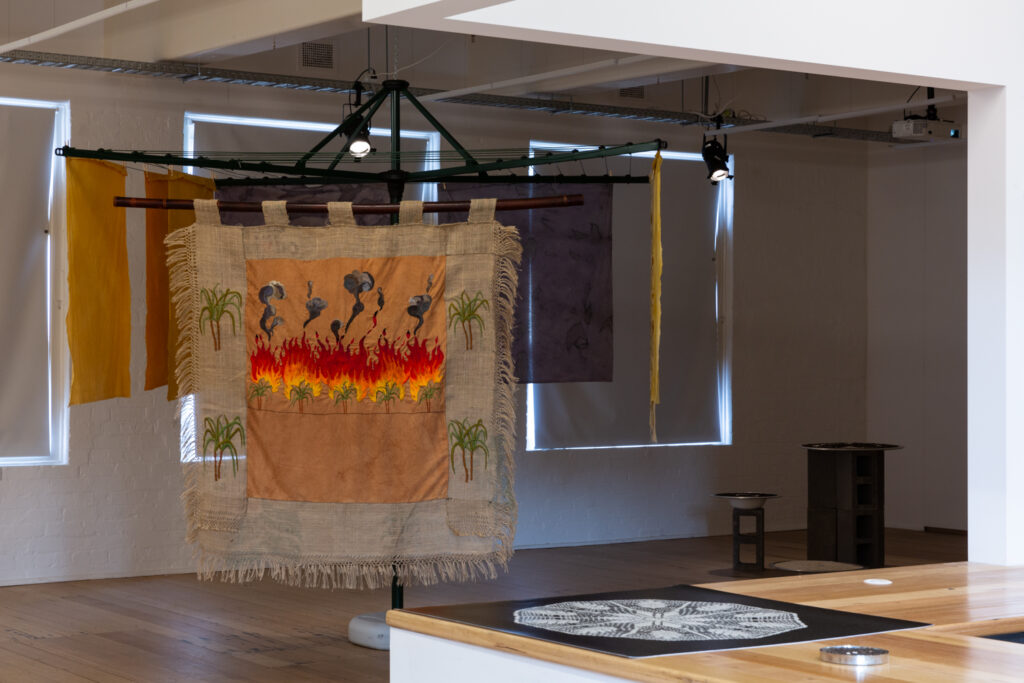
Arriving at Angna Mein, Indo-Fijian artists Quishile Charan and Zaiba Khan generously introduce us to their inherited craft-based practices. Described as “a seeding of memories,” both Charan and Khan offer tender renditions of the handicrafts passed down from their grandmothers; Khan’s dadi and Charan’s aaji. In these works we are introduced to the passing down of narratives, histories, and legacies, with Khan and Charan sharing the cultural practices inherited through the hands and spirits of their elders and ancestors. Speaking to my previous longing for interconnectedness, Angna Mein breathes life into these metaphors, speaking of connection seen and unseen: from Khan’s dadi’s crochet to Charan’s Mala / using rice to count even if it takes a lifetime, there is a nourishing connection between the quite literally big and small.
Entering West Space, immediately I noticed the draped textiles in the middle of the L-shaped room, hanging at the junction of the room’s two halves. I beelined for Burning Ganna Khet (Burning Sugarcane Farm), which depicts the burning of five sugarcane plants, bright yellow, orange and red threads embroidered into licking flames and, above them, plumes of smoke. I have since learned that Charan’s relatives grow and harvest sugarcane in Nadi, Fiji, and that the sugarcane plants are intentionally set alight in a process known as controlled burning.2 As someone for whom the sight of fire is unfamiliar, this piece simultaneously drew me in and took me aback. Knowing now how familiar this sight is to Charan, its necessity in the practice of harvesting sugarcane, and how she spent over a year embroidering it into being, it set the tone of the remainder of the exhibition: grounded, giving, and rich in narrative.
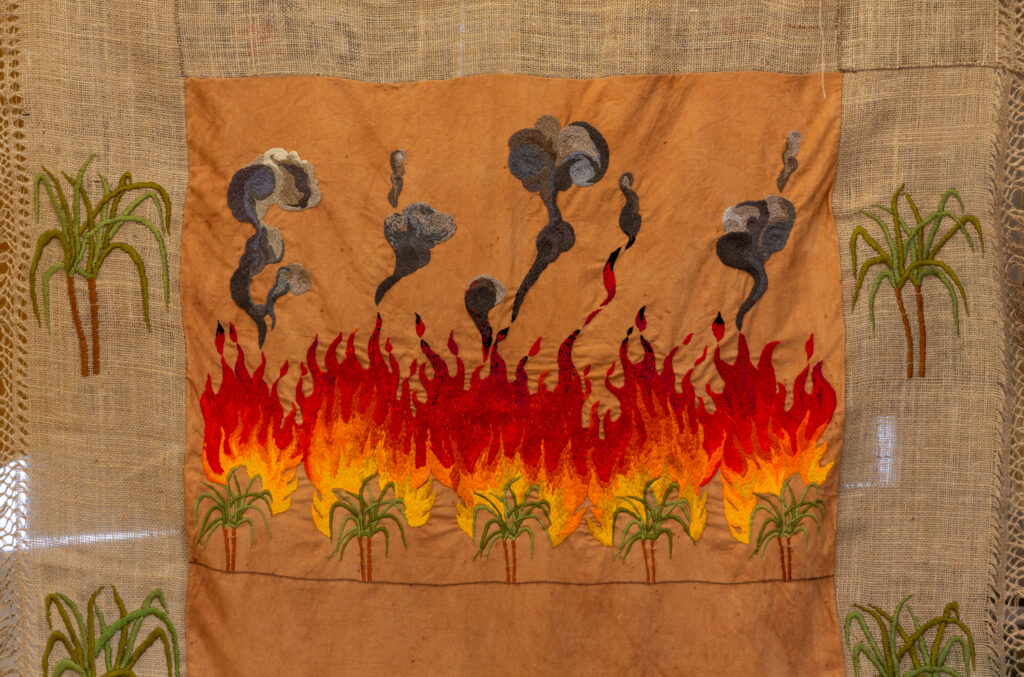
From there I noticed the moving image on an adjacent wall, Ghar Par Lovo (Lovo at Home), a six-minute video depicting Charan eco-dyeing textiles using a Fijian earth oven; a lovo. In the film we observe the collection and dispersion of hibiscus, pomegranate, and other natural materials onto cotton, bundling and tying them together, and preparing the lovo to steam these bundles such that the natural pigments are released into the textiles. This film shows us just how delicate this work is, how tender and caring a practice. The dyeing process, passed on to Charan from an elder in Savusavu, introduces us to and then immediately enmeshes us in Charan’s pride in and love for her culture and community.
Turning back to the textiles hung in the middle of the room, we get to see some of these completed works. Onion skins 1 - 3 resemble a sheet of subtle marigold, whereas Hibiscus phool dye 1 and 2 are almost charcoal in pigment. I particularly loved the detail in Hibiscus and genda phool eco-dye, which depict remnants of the materials as they were lain on the cotton. Having just witnessed how these patterns are made, the imagery I’d just watched for six minutes slow-dancing before me, I imagine Charan delicately laying the hibiscus and marigold flowers down on this particular piece of cotton. Even getting to bear witness to the finished result feels like a gift.
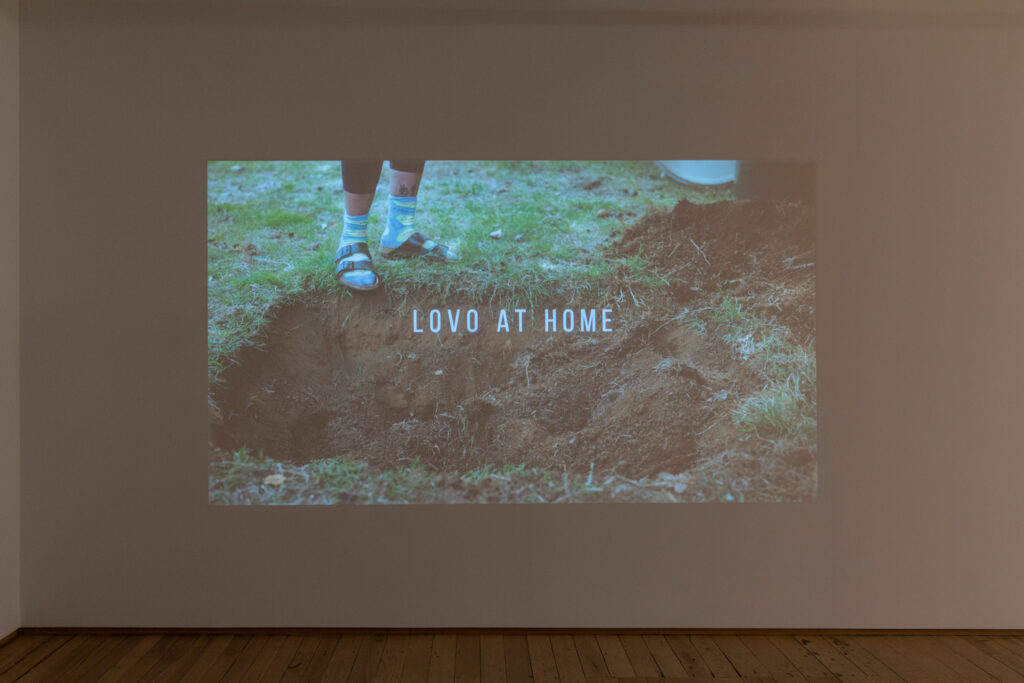
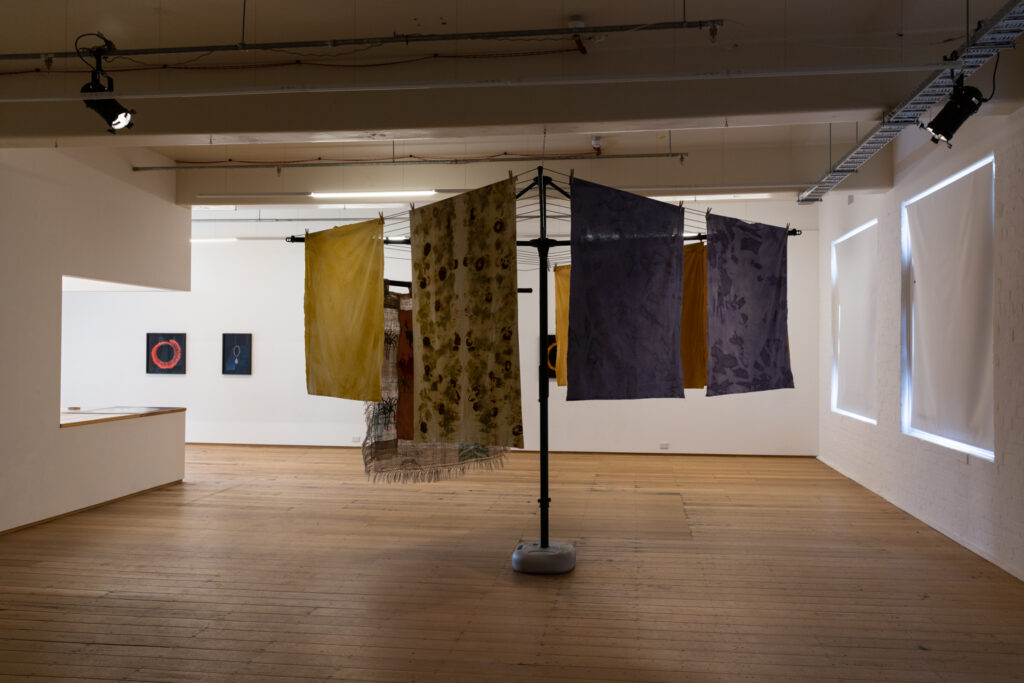
Much like Charan’s representations of her ancestor’s work with sugarcane, so too does Khan introduce us to her ancestor’s labours. In dhan ke khet - in the rice field Khan has cast 578 grains of rice in silver and woven them together into a necklace. From a distance the grains of rice resemble teeth, reminiscent of wàseisei or wasekaseka, necklaces made from the teeth of sperm whales.3 These precious and prized teeth were of great significance among Fijians and other Pacific island peoples, in part because of how labour-intensive the practice of extracting, sawing, shaping and polishing these teeth were. The substitution of rice in Khan’s work read like a nod to the similarly labour-intensive work of rice farmers and an homage to the sanctity of all natural substances: tooth and grain alike.
Rice appears several times in Khan’s work, each piece displayed on a haandi lid belonging to or borrowed from one of Khan’s relatives. 4.48 kilos of rice is equivalent to 69,248 grains, Upon the passing of a loved one we count la ilaha illAllah 70,000 times translates each one of Khan’s mother’s prayers into a single grain of rice, together making a basin of rice grains. Prayer, a traditionally intangible practice, is given a body here, and once again we are introduced to the potential power and divinity of rice.
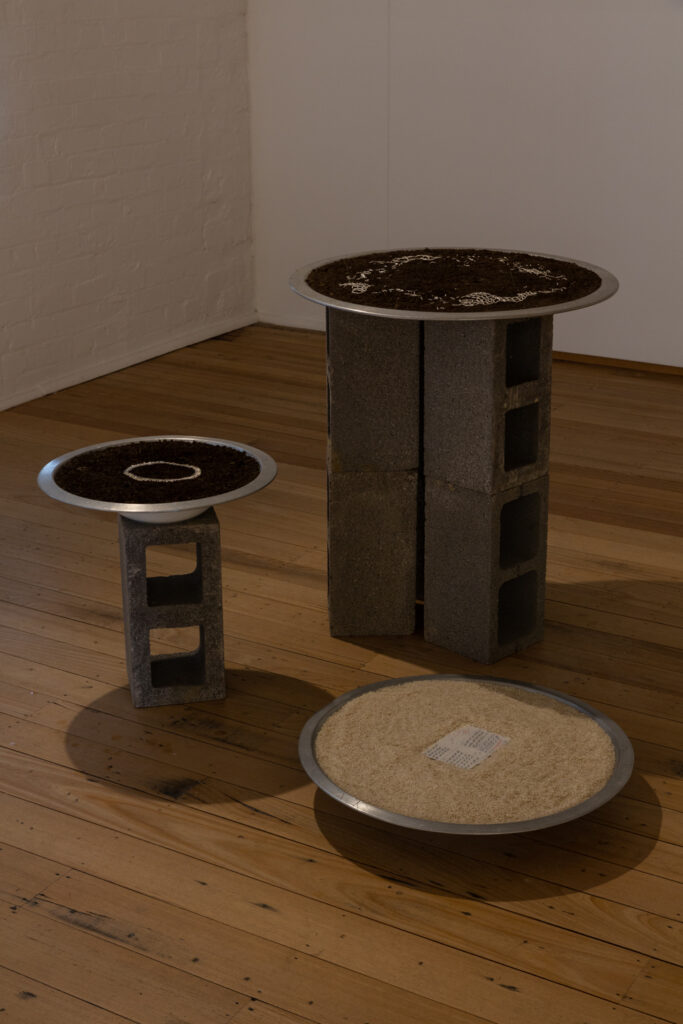
Although Khan’s malas were displayed on the wall closest to the entrance of West Space, I chose to leave them until the end of my time at Angna Mein. A mala, or ‘garland’ in English, can be used in meditation, as is the case with mālā beads, worn as an adornment, or hung as decoration in times of celebration.4 I begun taking in Khan’s malas with For the love of Stanley Street, in which Khan has modelled a mala with the remaining jacaranda of the year’s season. I’m immediately reminded of jacaranda season in Boorloo, how as quickly as the flowers grew on the trees were they strewn across the ground, and how stepping on them was inevitable, though I always tried my hardest not to. Knowing that Khan picked up and cupped final 25 flowers to be cast together is such a tender act to behold. It once again speaks to the ways in which Khan takes seemingly everyday organic matter and reminds us of their sanctity.
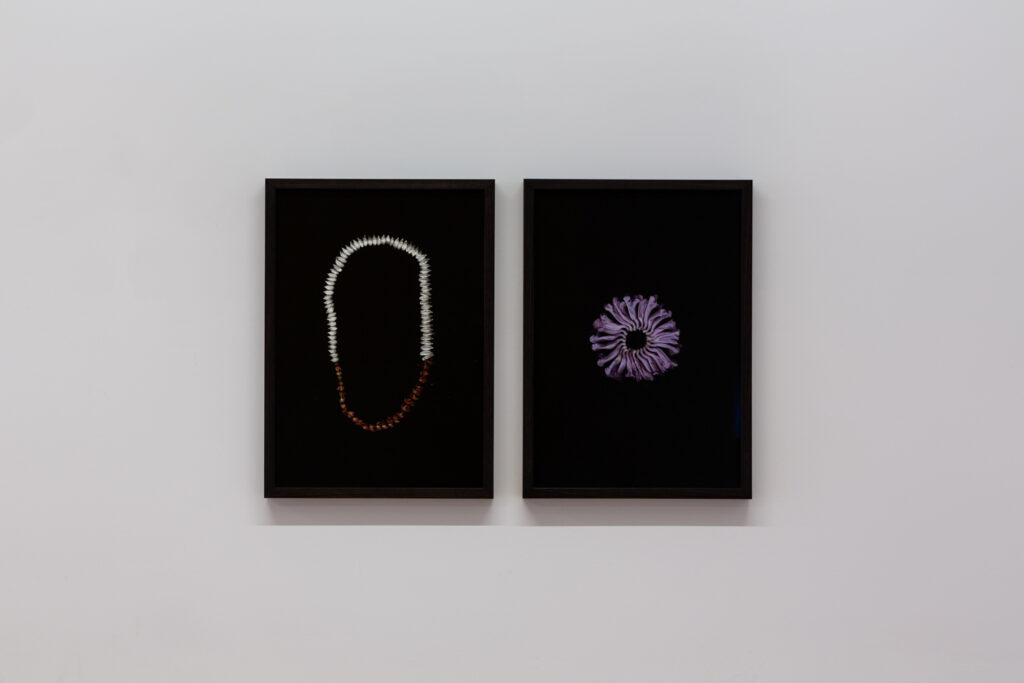
Across the remaining malas, Khan threads together kōwhai, carnellias, date seeds and fuchsia, each wreath dedicated to a particular moment, memory, or time of mourning in Khan’s life or the life of a loved one. This potent dedication to erecting a visual language for love and loss has me feeling picked apart and tenderly sewn back together. Seeing how both Khan and Charan honour their ancestral practices, intertwining them with their own complicated experiences of grief and longing, is a profound reminder of how our histories are passed down and stored within our bodies, how any and every material can be used to translate these histories into a visual language, and how our hands are the tools with which we can write it.
Julia Rose Bak is a queer, Māori-Polish writer and organiser living on Wurundjeri land in Narrm. Their writing touches on themes such as access, interdependence, care, collective healing and collective liberation, as well as their experience growing up with complex chronic illness. Julia was a 2022 Wheeler Centre Hot Desk Fellow and their writing can be read in Overland, Archer, Bitch and more.
un Projects’ Editor-in-Residence Program is supported by the City of Yarra.
